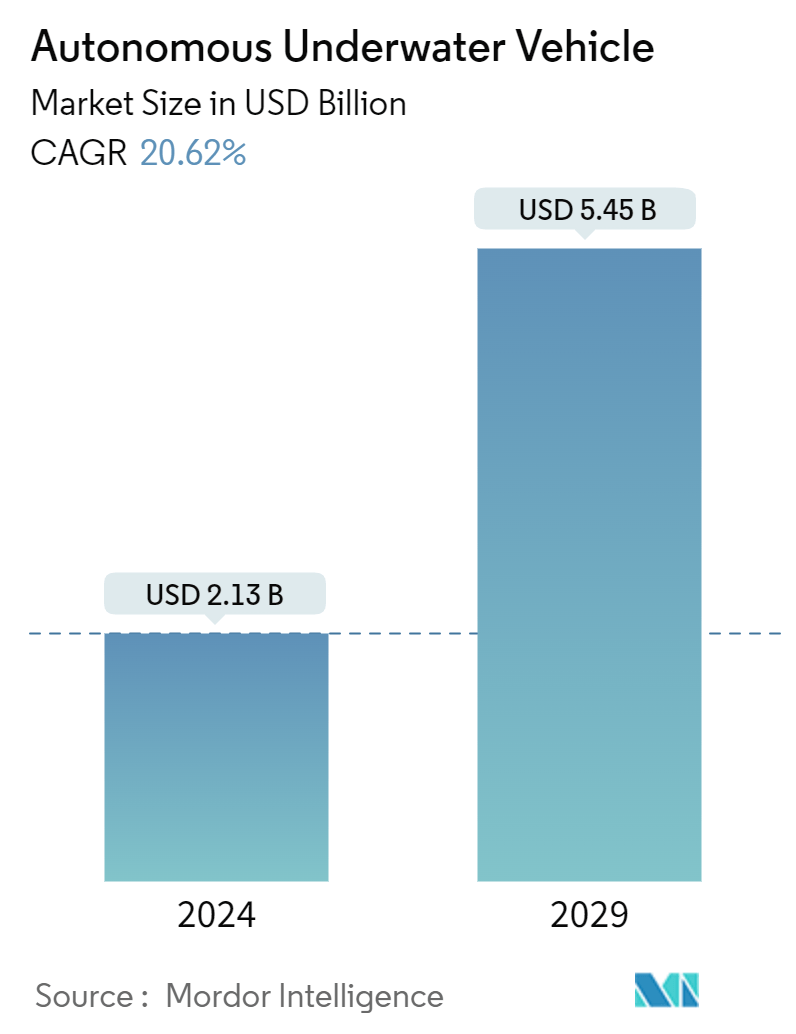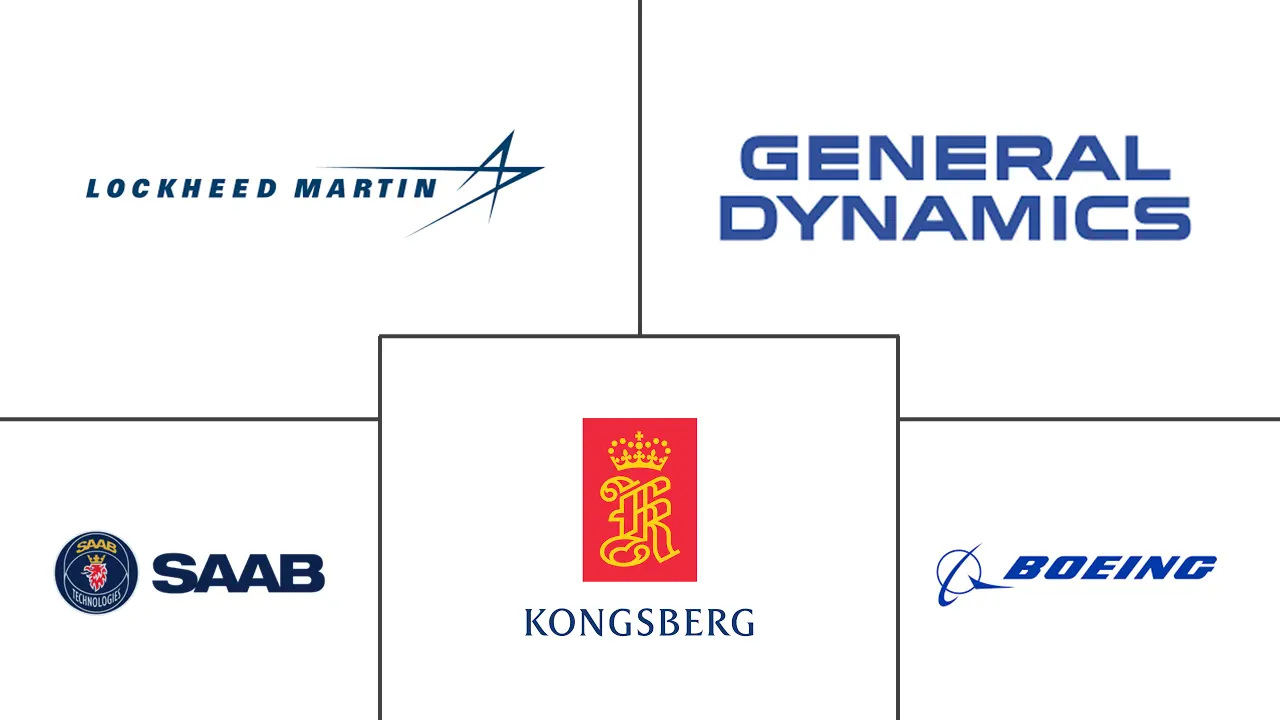Market Size of Autonomous Underwater Vehicles

| Study Period | 2019 - 2029 |
| Market Size (2024) | USD 2.13 Billion |
| Market Size (2029) | USD 5.45 Billion |
| CAGR (2024 - 2029) | 20.62 % |
| Fastest Growing Market | North America |
| Largest Market | North America |
| Market Concentration | Low |
Major Players
*Disclaimer: Major Players sorted in no particular order |
Autonomous Underwater Vehicles Market Analysis
The Autonomous Underwater Vehicle Market size is estimated at USD 2.13 billion in 2024, and is expected to reach USD 5.45 billion by 2029, growing at a CAGR of 20.62% during the forecast period (2024-2029).
The market is driven by the wide applications of autonomous underwater vehicles (AUVs) in multiple sectors, such as exploration and research, resource exploration, environment monitoring, defense and security, infrastructure inspection, and scientific research.
The adoption of AUVs has also increased due to their stability, low deployment cost, improved data quality, and excellent navigation algorithms. These benefits have made applying autonomous underwater vehicles a safe option for many. For instance, they are deployed in the oil and gas industry to create seafloor maps. The military also uses them for inspection and identification. This has aided commerce and security in many nations.
Underwater vehicle technology is expected to lead to attractive opportunities for manufacturing companies. Developing cost-effective communication technology for underwater vehicles with excellent disturbance tolerance will significantly fuel market growth.
However, increasing operational costs and uncertainty in the operational performance of AUVs are likely to hinder market growth.
Autonomous Underwater Vehicles Industry Segmentation
Autonomous underwater vehicles (AUVs) are unmanned underwater robots designed to operate independently without direct human control. They are equipped with sensors, navigational systems, and propulsion systems to perform various tasks such as oceanographic research, underwater mapping, pipeline inspection, and military applications.
The autonomous underwater vehicles market is segmented by type, application, and geography. By type, the market is segmented into small, medium, and large. By application, the market is segmented into military & defense, oil & gas, environment protection & monitoring, oceanography, archeology & exploration, and search & salvage operations. The report also covers the market sizes and forecasts for the autonomous underwater vehicles market in major countries across different regions. For each segment, the market size is provided in terms of value (USD).
| By Type | |
| Small | |
| Medium | |
| Large |
| By Application | |
| Military & Defense | |
| Oil & Gas | |
| Environment Protection & Monitoring | |
| Oceanography | |
| Archaeology & Exploration | |
| Search & Salvage Operations |
| Geography | |||||||
| |||||||
| |||||||
| |||||||
| |||||||
|
Autonomous Underwater Vehicles Size Summary
The autonomous underwater vehicles (AUVs) market is poised for significant growth, driven by their diverse applications across sectors such as exploration, defense, and environmental monitoring. AUVs are increasingly favored for their stability, cost-effectiveness, and advanced navigation capabilities, making them a reliable choice for tasks like seafloor mapping and military reconnaissance. The technology's potential to enhance maritime security and operational efficiency is attracting substantial investment, particularly in defense, where AUVs are used for surveillance and mine countermeasures. However, challenges such as high operational costs and performance uncertainties may impede market expansion.
North America is expected to lead the market growth, supported by robust demand from the US Navy and ongoing research and development efforts. The region's strategic investments in autonomous systems, especially amid rising geopolitical tensions, are further propelling market dynamics. The market landscape is characterized by a mix of established players and emerging startups, with companies like Kongsberg Gruppen ASA and The Boeing Company actively pursuing strategic initiatives to strengthen their market positions. These developments, coupled with increasing global military expenditure and the need for advanced underwater capabilities, are anticipated to drive the market forward.
Autonomous Underwater Vehicles Market Size - Table of Contents
-
1. MARKET DYNAMICS
-
1.1 Market Overview
-
1.2 Market Drivers
-
1.3 Market Restraints
-
1.4 Porter's Five Force Analysis
-
1.4.1 Threat of New Entrants
-
1.4.2 Bargaining Power of Buyers/Consumers
-
1.4.3 Bargaining Power of Suppliers
-
1.4.4 Threat of Substitute Products
-
1.4.5 Intensity of Competitive Rivalry
-
-
-
2. MARKET SEGMENTATION
-
2.1 By Type
-
2.1.1 Small
-
2.1.2 Medium
-
2.1.3 Large
-
-
2.2 By Application
-
2.2.1 Military & Defense
-
2.2.2 Oil & Gas
-
2.2.3 Environment Protection & Monitoring
-
2.2.4 Oceanography
-
2.2.5 Archaeology & Exploration
-
2.2.6 Search & Salvage Operations
-
-
2.3 Geography
-
2.3.1 North America
-
2.3.1.1 United States
-
2.3.1.2 Canada
-
-
2.3.2 Europe
-
2.3.2.1 United Kingdom
-
2.3.2.2 France
-
2.3.2.3 Germany
-
2.3.2.4 Russia
-
2.3.2.5 Rest of Europe
-
-
2.3.3 Asia-Pacific
-
2.3.3.1 India
-
2.3.3.2 China
-
2.3.3.3 Japan
-
2.3.3.4 South Korea
-
2.3.3.5 Rest of Asia-Pacific
-
-
2.3.4 Latin America
-
2.3.4.1 Brazil
-
2.3.4.2 Rest of Latin America
-
-
2.3.5 Middle East and Africa
-
2.3.5.1 United Arab Emirates
-
2.3.5.2 Saudi Arabia
-
2.3.5.3 Israel
-
2.3.5.4 Rest of Middle East and Africa
-
-
-
Autonomous Underwater Vehicles Market Size FAQs
How big is the Autonomous Underwater Vehicles Market?
The Autonomous Underwater Vehicles Market size is expected to reach USD 2.13 billion in 2024 and grow at a CAGR of 20.62% to reach USD 5.45 billion by 2029.
What is the current Autonomous Underwater Vehicles Market size?
In 2024, the Autonomous Underwater Vehicles Market size is expected to reach USD 2.13 billion.

